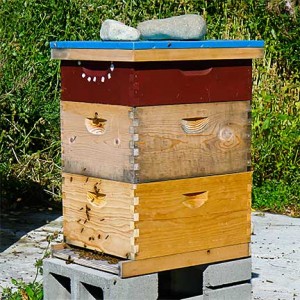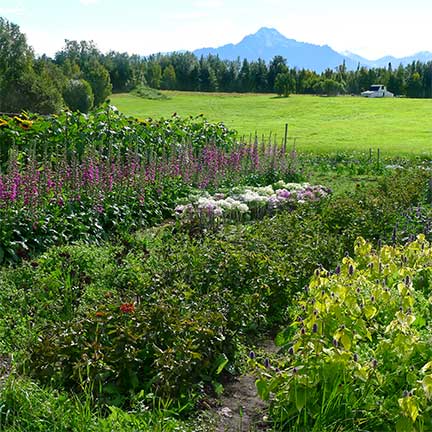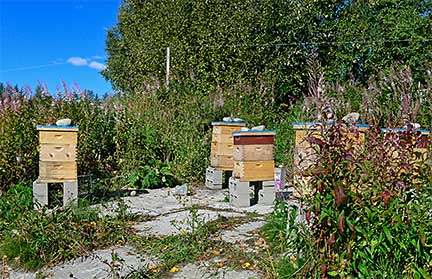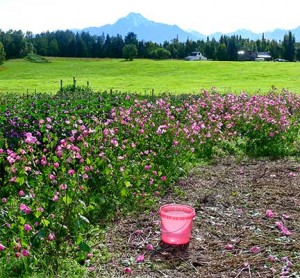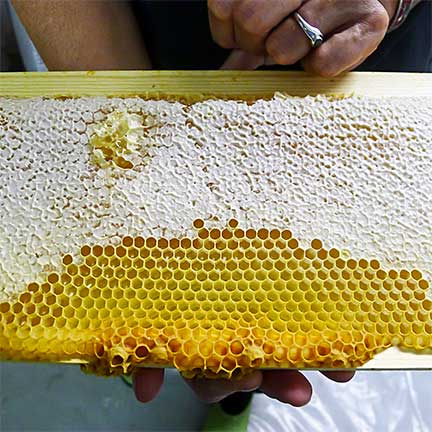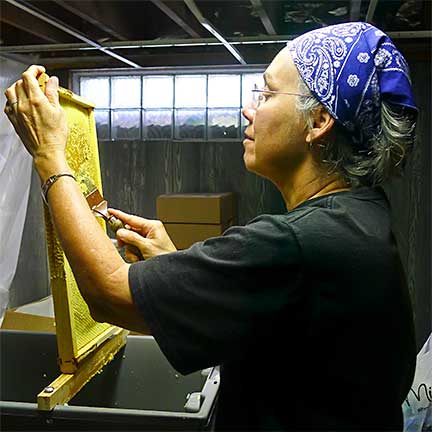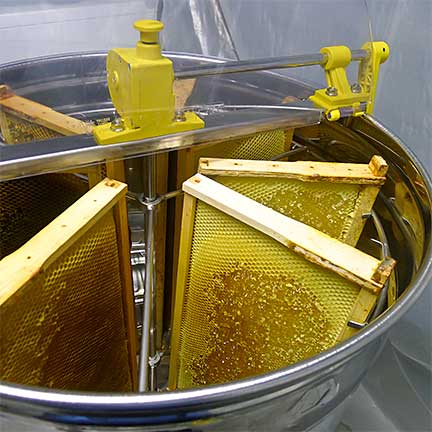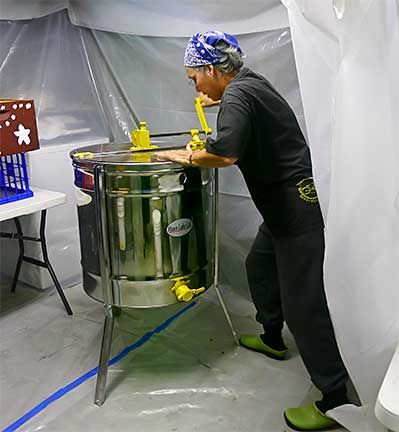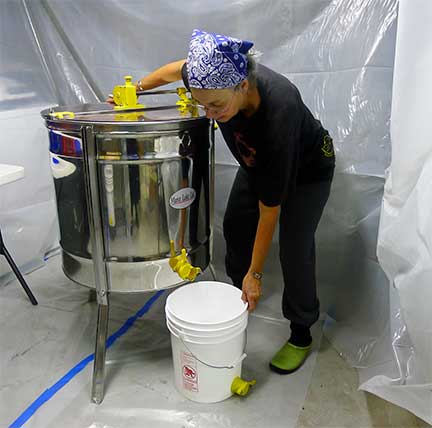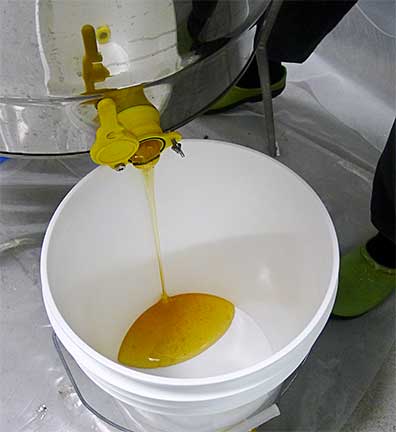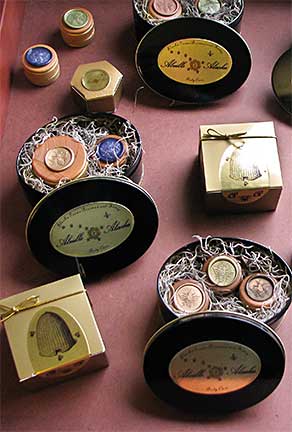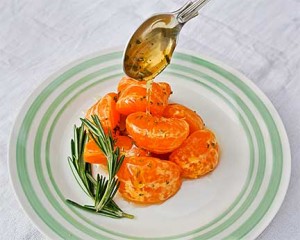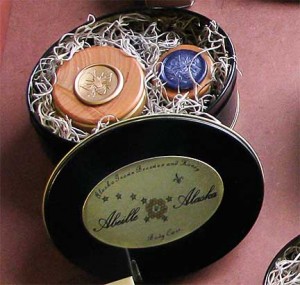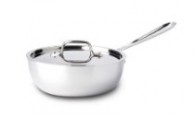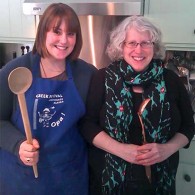“Do you get stung?” The question burst out of me, unbidden, with an edge of bee-phobic panic I tried to hide. I nervously approached Beverly Barker’s door. Bees were everywhere.
“All the time!” Beverly laughed. “I have to expect getting stung.” She explained bees sting when they’re stressed: “The more focused I am, the less likely I’ll excite the bees and get stung. When bees are agitated, it takes them time to calm down. Bees have a stress pheromone that smells like bananas. When I smell the pheromone, I know the bees are stressed, but as a commercial beekeeper, I can’t wait for them to calm down. So I get stung.”
One of Beverly’s grandfathers was a beekeeper. His attitude towards bees shaped hers: “I’m not afraid of bees because my grandfather wasn’t afraid of them. He didn’t use smoke or a suit. I once asked my grandfather if he was afraid of the bees. He said no, even though he got stung all the time. He was so nonchalant, it didn’t dawn on me to be afraid.”
In fall 2009, Beverly and her husband, Bruce Hougan, bought 7-acres of untamed farmland in Palmer, Alaska and dubbed it Earthworks Farm. She’d recently left her job as a chemistry professor at University of Alaska and decided a life change was in order. Bruce had worked in gardens and vineyards for most of his life; he welcomed the opportunity to have a farm of his own.
The first year, 2010, was a challenge. “When we moved in, there were no birds and no insects. The land had gone fallow and was choked with weeds. Bruce was concerned that with no insects, our plants wouldn’t be pollinated.” To deal with this problem, Bruce suggested Beverly start raising bees, one of her lifelong dreams. She was thrilled by the idea.
Beverly’s 2010 entry into the world of beekeeping didn’t go smoothly: “My first year, I completely bombed as a beekeeper. I stopped feeding my bees in the spring, just like the books advise, but there weren’t yet any plant blossoms for them to feed on. I let them starve to death. I was crying, in tears.” Beverly keenly felt her failure, believing she “had let down the bees.”
Having learned a beekeeping lesson the hard way, Beverly started over in 2011 with two hives. “I can’t believe how much I babied them. Last year, when my husband couldn’t find me in the field, he knew I was in the bee yard checking to see if everything was okay.” Bruce was aggravated by how much time Beverly spent with the bees, “until last fall when we had our first honey crop.”
Many beekeepers rely on wildflowers for bee food. There are wildflowers around their property, but not enough to sustain 10 hives of bees, which is what Beverly now has. Her bees also feed on the vegetables and flowers Bruce raises to sell at their farm stand or the South Anchorage Farmers’ Market.
Honey’s flavor depends on what bees eat. “Something we’re growing, we haven’t yet determined what, gives our honey a special scent, a special flavor,” said Beverly. This year, expert Alaskan beekeepers advised Beverly to harvest honey early, at the peak harvest time for vegetables. Beverly harvested a few frames early, but “they didn’t have the scent” so she waited before harvesting the rest. Waiting wasn’t in vain, Beverly’s late-harvested honey had finally acquired “the scent.”
To protect her honey’s flavor, and to preserve its full nutritional benefits, Beverly sells only raw honey and takes care not to damage it with heat. (Most store-bought honey is pasteurized rather than raw.) Since raw honey crystallizes faster when cold, Beverley keeps her basement honey room at 70°F, warm enough to keep the honey flowing.
Honey is hydroscopic, which means it grabs water molecules from the air, increasing its water content and ruining its flavor. To prevent this, when Beverly pulls frames from hives at harvest time, she brings them inside her honey room where a dehumidifier is running. Beverly runs the dehumidifier nonstop from her first harvest until she finishes bottling all the honey.
Before extracting honey from the comb, Beverly checks the quality by measuring its moisture level. Grade A honey has lower than 17.5% moisture. With higher moisture levels, honey may start fermenting. Beverly also keeps her equipment and bee room impeccably clean to prevent impurities from contaminating the honey.
In addition to honey, Beverly harvests and processes beeswax, which she uses along with honey to make her cosmetic line, Abeille Alaska. ‘Abeille’ (uh-BAY) means ‘bee’ in French. Beverly currently makes Abeille Alaska moisturizing and deodorant creams, and plans to expand her line further.
Beverly started her cosmetics line in 2011. At the end of fall, she and Bruce no longer had flowers or vegetables to sell. They cast about for alternate sources of income. Beverly started thinking about making moisturizing cream, similar to Burt’s Bees.
For her first batch, she rendered cappings, the wax cover bees use to store honey, and burr comb, the wax cells bees make to fill empty space in the hive, in olive oil and put it in jars. It sold out quickly: “People liked its purity. Since then, I’ve made my creams better by using coconut and almond oils. I love the way these oils combine with beeswax and honey.”
This year, Beverly expanded Abeille Alaska’s product line to include lip balms, lotion bars, moisturizing creams, perfume, and deodorant. She also upgraded the packaging with bee-themed containers.
Beverly and Bruce will be selling Abeille Alaska products at the Christmas Arts and Crafts Emporium (Booths 108 &109) at the Dena’ina Center in Anchorage on November 17-18, 2012. They will also be at the Alaska-Juneau Public Market (Centennial Hall) in Juneau November 23-25, 2012.
Last year, Beverly successfully overwintered two hives. This year she is overwintering ten and plans to further expand Abeille Alaska next year. “I really love bees. That helps a lot. When you love something, you can put up with a few little idiosyncrasies.” Like getting stung? “Exactly!”
My favorite way to eat Beverly’s raw honey is drizzled over Greek yogurt or spread on toast. It also pairs well with fruit and nuts. I like serving lightly honeyed fruit for simple yet delicious desserts. Mandarin Oranges with Rosemary Honey and Honey-Grilled Figs with Lemon Mascarpone are two of my favorite honeyed fruit desserts.



